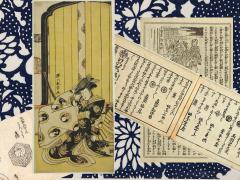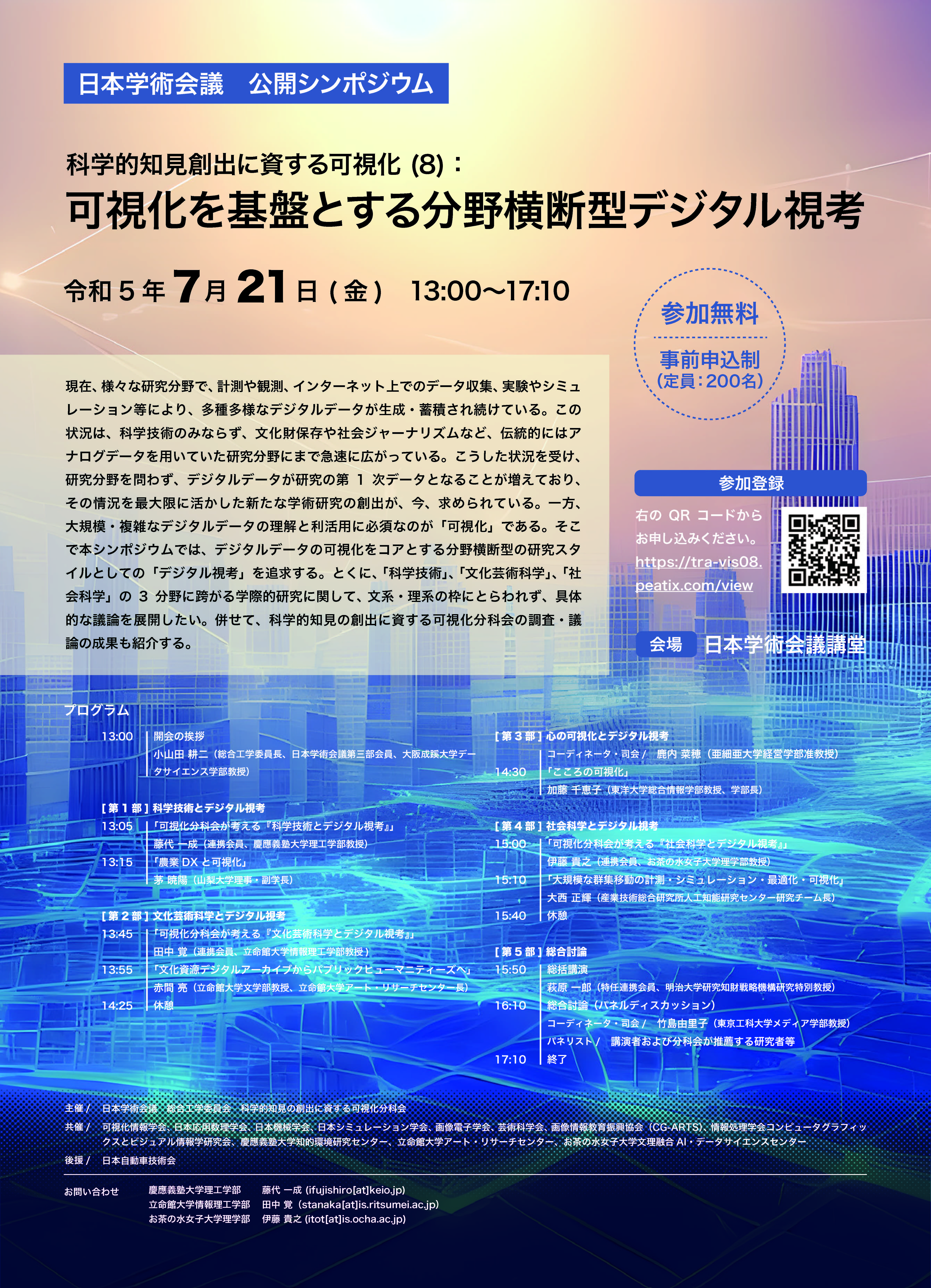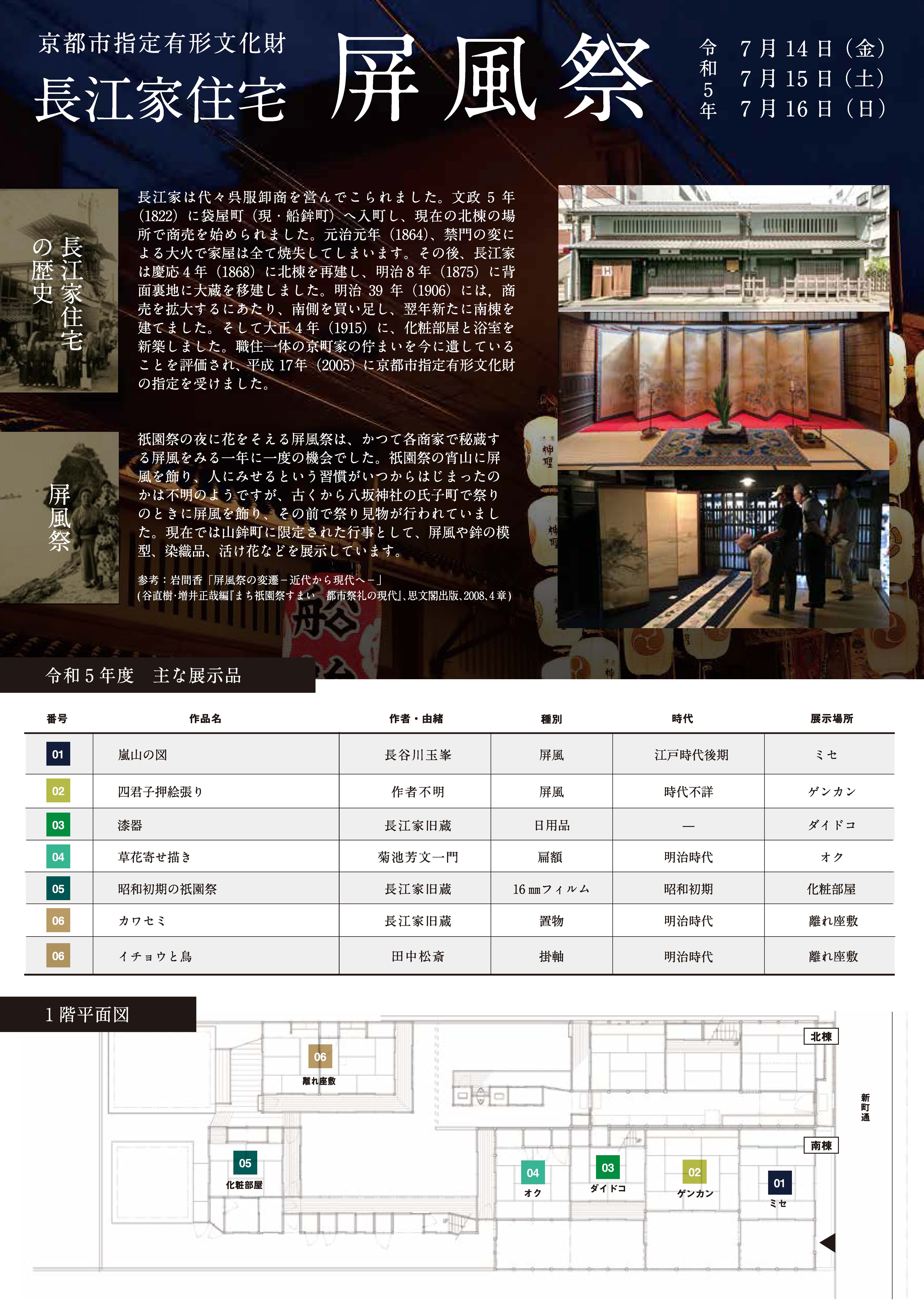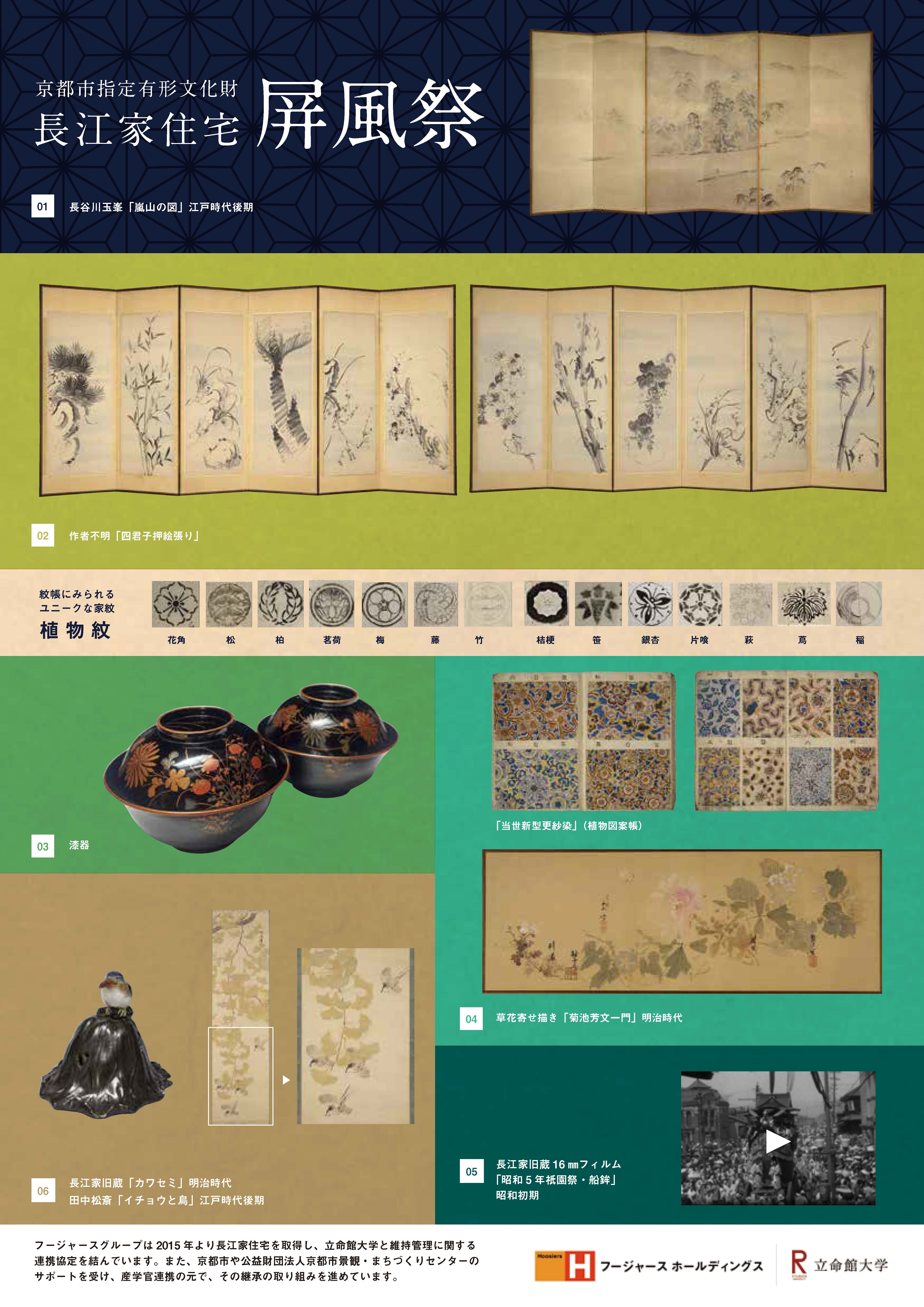-

The Saturday Seminar Series, a public serminar series of Ritsumeikan University, will be organized by the Art Research Center (ARC), Ritsumeikan University, in September 2023.
Theme: 京焼登り窯の新研究-3D計測と新資料を中心に-
Date: September 16 (Sat), 2023, 10:00 - 11:30
Online eventTopic: 京焼登り窯の新研究2-3D計測で⾒る登り窯-
Speaker: Ahmad Yama NAWABI(Institute for Cultural Heritage, Waseda University)
Participation is free of charge・Advance registration required (max. 400)
>>Register here.
>>Website of the Ritsumeikan University Saturday Seminar Series
[イベント情報]September 15, 2023(Fri)We are pleased to announce the Joint Colloquium Theory and Methods in the Japanese Humanities: Research Using Visual Sources and Archives, co-organized by the Center for Japanese Studies (CJS), University of California, Berkeley, and the Art Research Center (ARC), Ritsumeikan University.
Date: September 15 (Fri), 16:00-18:00 PDT / September 16 (Sat), 8:00-10:00 JST
Venue: Rm 370, Dwinelle Hall, University of California, Berkeley + online via ZOOM (※This is a non-public event.)
Faculty and graduate students from the Center for Japanese Studies (CJS), University of California, Berkeley, and the Art Research Center (ARC), Ritsumeikan University, will present on the use of visual sources and archives in their research. While discussing the specific content of their respective research projects, the presenters will discuss and exchange research methods, approaches, and techniques for employing visual sources and archives.
Program
16:00 - 16:05 Opening remarks by Prof. Jonathan E. ZWICKER (Center for Japanese Studies, Dept. of East Asian Languages and Cultures, University of California, Berkeley)
16:05 - 16:25 The Value of Visual Sources in Digital Archives for Researching the Ryukyu Kingdom's Embassies to Edo (held in English)
Speaker: Dr. Travis SEIFMAN (Kinugasa Research Organization, Ritsumeikan University/Research Manager of the ARC)
16:25 - 16:40 The Utility of Digital Archives in Kabuki Research: Focusing on an Approach Using Actor's Prints from the Mid-Edo Period (held in English)
Speaker: Shiori TOTSUKA (PhD Student, Graduate School of Letters, Ritsumeikan University)
16:40 - 16:55 An Attempt to Construct a Design Encyclopedia Using Digital Archives (held in English)
Speaker: Risako HIRANO (PhD Student, Graduate School of Letters, Ritsumeikan University)
-Break (5 minutes)-
17:00 - 17:15 The Comedy of Inoue Hisashi and the Critique of Modern Japan (held in English)
Speaker: Megumi HIROTA (MA Student in Asian Studies, University of California, Berkeley)
17:15 - 17:30 帝国日本の銃後の主体性 (Agency) -1943年の一枚のプロパガンダ小説、辻小説を中心に- (held in Japanese)
Speaker: Hong JANG (PhD Student in East Asian Languages and Cultures, University of California, Berkeley)
17:30 - 17:45 Archival Hesitancies: Problems of Research as Method (held in English)
Speaker: Frank CAHILL (PhD Student in Comparative Literature, University of California, Berkeley)
17:45 - 17:55 Discussion
17:55 - 18:00 Closing remarks by Prof. Ryo AKAMA (Direcor of the ARC/College of Letters, Ritsumeikan University)
18:00 ~ Reception
This colloquium is supported by the International Joint Digital Archiving Center for Japanese Art and Culture (ARC-iJAC), Art Research Center, Ritsumeikan University.

The Saturday Seminar Series, a public serminar series of Ritsumeikan University, will be organized by the Art Research Center (ARC), Ritsumeikan University, in September 2023.
Theme: 京焼登り窯の新研究-3D計測と新資料を中心に-
1. 3388th Session
Date: September 9 (Sat), 2023, 10:00 - 11:30
Online eventTopic:京焼登り窯の新研究1-五条坂「窯持」の近代-
Speaker:Takuma YOGO (Associate Professor, Faculty of Human Sciences, Waseda University)
Participation is free of charge・Advance registration required (max. 400)
>>Register here.2. 3389th Session
Date: September 16 (Sat), 2023, 10:00 - 11:30
Online eventTopic: 京焼登り窯の新研究2-3D計測で⾒る登り窯-
Speaker: Ahmad Yama NAWABI(Institute for Cultural Heritage, Waseda University)
Participation is free of charge・Advance registration required (max. 400)
>>Register here.
>>Website of the Ritsumeikan University Saturday Seminar Series
[イベント情報]August 10, 2023(Thu)We are pleased to announce the Call for Manuscript Submissions for the Art Research Center's journal ART RESEARCH vol. 24-3.
As an academic journal specializing in arts and culture, the purpose of ART RESEARCH is to widely publicize the results of the research projects and activities conducted by the Art Research Center (ARC), Ritsumeikan University, and its partner institutions and collaborative researchers.
Since its establishment in 1998, the Art Research Center (ARC) has been selected for several national grants as a center of excellence for research in culture, art, and information science. In FY2019, the center assumed the role as the International Joint Digital Archiving Center for Japanese Art & Culture (ARC-iJAC) upon its accreditation by the MEXT as an International Joint Usage/Research Center. The ARC is highly regarded as a leading hub for the digital archiving of Japanese art and culture.
Our online journal will be published several times a year, and at the end of the fiscal year, a print booklet compiling all contributions will be distributed, as we hope to increase the submission opportunities for researchers.
We look forward to receiving your manuscript.
Read more>>[イベント情報]July 29, 2023(Sat)As part of the international joint research project 'Creative Collaborations: Salons and Networks in Kyoto and Osaka 1780-1880'--supported by UK Research & Innovation (UKRI) and JSPS--a hybrid workshop will be held on July 29 (Sat).
Date: July 29 (Sat), 2023
2:00-6:00 PM(JST)
6:00-10:00 AM(BST)Venue: Hybrid workshop
・Art Research Center (ARC), Ritsumeikan University
・Online (Zoom)※This is a closed workshop. If you like to make an inquiry to participate, please send an e-mail to:
r-darc(at)st.ritsumei.ac.jp (replace 'at' with @)
 With the establishment of the International Joint Digital Archiving Center for Japanese Art and Culture (ARC-iJAC) in 2019, the Art Research Center strives to push the internationalization of research activities that transcend disciplines and geographic boundaries.
With the establishment of the International Joint Digital Archiving Center for Japanese Art and Culture (ARC-iJAC) in 2019, the Art Research Center strives to push the internationalization of research activities that transcend disciplines and geographic boundaries.NEWS
Save the date! ARC Days to be held on Aug 3 (Thurs) & Aug 4 (Fri)
 We were delighted to welcome Dr. Akiko Takesue, Bishop White Committee Associate Curator of Japanese Art & Culture at the Royal Ontario Museum (ROM), to the ARC.
We were delighted to welcome Dr. Akiko Takesue, Bishop White Committee Associate Curator of Japanese Art & Culture at the Royal Ontario Museum (ROM), to the ARC.
The ARC, in collaboration with the ROM, is pleased to announce that 4,233 ukiyo-e prints and 74 Japanese old books from ROM's collection are now available in the ARC database. >> Read more.ARC-iJAC Project Spotlights: An Interview with Masami Yamada (Curator, Asia Department, Victoria & Albert Museum)
Supported by the ARC-iJAC, Masami Yamada, Curator in the Asia Department of the Victoria and Albert Museum, has been leading the research project Re-thinking Japonisme: Digitization of the V&A's collection of Japanese illustrated books and researching its formation in the late 19th century. 
As part of this collaborative project, Dr. Ryoko Matsuba (SISJAC) regularly organizes hands-on workshops at the V&A for students & young researchers to learn about best practices in digitizing museum collections. >> Read more. 

The release comprises 1,541 ukiyo-e prints held by the UC Berkeley Art Museum and Pacific Film Archive. Particularly noteworthy are 134 surimono (摺物) and 120 pillar prints (柱絵), for which the opening of this database provides a foundation for further research. >> Read more. Video on demand! 116. International ARC Seminar Session 1: Simon KANER (Executive Director, Sainsbury Institute for the Study of Japanese Arts and Cultures, UEA)
Topic: Stonehenge and prehistoric Japan--Archaeological exchanges between Japan and the UK: Current and future trends
Session 2: Ryoko MATSUBA (Lecturer in Digital Japanese Arts and Humanities, Sainsbury Institute for the Study of Japanese Arts and Cultures, UEA), Joseph BILLS (MPhil, Univ. of Cambridge), Bori KO (MA Student, SOAS Univ. of London), Liam HEAD (MA Student, UEA)
Topic: Implementing the ARC Model in the UK: Digitising Sword Ornaments at the British Museum

The late Mukai Nobuo (向井信夫) was known as a collector and researcher of Edo-period Japanese books and also collected ukiyo-e prints and albums of the same period, including a sizeable collection of 690 works by Tsukioka Yoshitoshi (月岡芳年). >> Read more. 
The Takeuchi Dokei Collection is the world's largest collection of materials related to Edo-period Japanese music. Search for the Tokiwazu-bushi lyric booklets by entering 常磐津 in the "genre" (ジャンル) search box at the following >> link.
For a commentary by Takeuchi Yuichi (Research Institute for Japanese Traditional Music, Kyoto City University of Arts), >> click here.
Faculty News! We are pleased to welcome Dr. Travis Seifman as Research Manager / Associate Professor to the ARC faculty.
Originally from New York, he completed MA degrees in Japanese Studies at SOAS, University of London, and in Art History at the University of Hawaiʻi at Mānoa before earning his Ph.D. in History at the University of California, Santa Barbara.Before joining the ARC, he worked as a postdoctoral Project Researcher at the University of Tokyo Historiographical Institute. Dr. Seifman specializes in Okinawan Studies and researches in particular the embassies dispatched by the Okinawan kingdom of Lūchū (Ryūkyū) to Edo in the 17th to 19th centuries. Upcoming Events
July 26 (Wed), 2023, 18:00-19:30 JST
122. International ARC Seminar
Speaker: Travis SEIFMAN (Associate Professor & Research Manager, Kinugasa Research Organization, Ritsumeikan University)
Topic: Visual, Material, and Performance Culture Aspects of the Ryukyu Kingdom's Embassies to Edo (held in Japanese)
August 3 (Thurs), 2023, 14:00-16:45 JST
August 4 (Fri), 2023, 10:00-17:35 JST
ARC Days 2023
An annual event where faculty members of the ARC and international collaborative researchers introduce their research projects in Digital Humanities (DH).
>> Click here for the program.
Live stream available via >> YouTube.


Previous issues:
Spring 2023, Winter 2022, Autumn 2022, Summer 2022, Spring 2022, Winter 2021, Autumn 2021, Summer 2021, Spring 2021, Winter 2020, Autumn 2020, Summer 2020, Spring 2020view this email in your browser Copyright © 2021 Art Research Center, Ritsumeikan University. All rights reserved.
Our mailing address is:
56-1 Toji-in Kitamachi, Kita-ku, Kyoto 603-8577 JAPAN
Want to change how you receive these emails?
You can update your preferences or unsubscribe from this list.[イベント情報]July 26, 2023(Wed)The 122nd International ARC Seminar will be held as a webinar on Wednesday, July 26, from 18:00 JST.
The program is as follows:
Speaker: Travis SEIFMAN (Associate Professor & Research Manager, Kinugasa Research Organization, Ritsumeikan University)
Topic: Visual, Material, and Performance Culture Aspects of the Ryukyu Kingdom's Embassies to Edo
Date: Wednesday, July 26, 18:00 - 19:30 JST
Participation: online via Zoom, free of charge (no reservation required)
*This webinar is open to everyone, and non-ARC members are also invited to participate via YouTube.
[イベント情報]July 21, 2023(Fri)The Science Council of Japan presents:
Public Symposium: Scientific Knowledge Generation facilitated by Visualization (8): Cross-Disciplinary Digital Perspectives based on Visualization
From the Art Research Center (ARC), Ritsumeikan University, Professor Ryo Akama (Director of the ARC/College of Letters) and Professor Satoshi Tanaka (College of Information Science and Engineering) will deliver presentations in the 2nd part of the program.
Date: July 21 (Fri), 2023, 13:00-17:10 (JST)
Venue: Auditorium, Science Council of Japan
Entry is free of charge (maximum capacity of 200 persons). Advance registration is required.Please register here >>https://tra-vis08.peatix.com/view
Event outline:
現在、理系/文系を問わず、様々な研究分野で、多種多様なデジタルデータが生成・蓄積され続けている。こうした情況を受けて本シンポジウムシリーズでは、ビッグデータ時代に相応しい、可視化をコアとする分野横断型の研究手法を検討してきた。シリーズ第8回の今回は、これまでの7回の集大成として、科学技術、文化芸術科学、社会科学の3つの分野を中心に、ビッグデータ時代に相応しい「デジタル視考」と、それを可能にする基盤環境について考えます。Inquiries:
慶應義塾大学理工学部 藤代 一成 (ifujishiro@keio.jp)
立命館大学情報理工学部 田中 覚(stanaka@is.ritsumei.ac.jp)
お茶の水女子大学理学部 伊藤 貴之 (itot@is.ocha.ac.jp)
Organized by: 日本学術会議 総合工学委員会 科学的知見の創出に資する可視化分科会 Co-organized by: 可視化情報学会、日本応用数理学会、日本機械学会、日本シミュレーション学会、画像電子学会、芸術科学会、画像情報教育振興協会(CG-ARTS)、情報処理学会コンピュータグラフィックスとビジュアル情報学研究会、慶應義塾大学知的環境研究センター、立命館大学アート・リサーチセンター、お茶の水女子大学文理融合 AI・データサイエンスセンター Supported by: 日本自動車技術会 [イベント情報]July 19, 2023(Wed)Background:
Masami Yamada, leader of the ARC-iJAC project Re-thinking Japonisme: Digitization of the V&A's collection of Japanese illustrated books and researching its formation in the late 19th century, is a Curator in the Victoria and Albert Museum's Asia Department. She has particular responsibility for the collections of Japanese lacquerware, netsuke, ukiyo-e woodblock prints and contemporary craft. Her current area of research is contemporary craft, particularly the work of urushi lacquer artists. In 2022, she received the inaugural Sir Nicholas Goodison Award for Contemporary Craft from the Art Fund to further develop the Museum's internationally renowned Japanese lacquer collection.Thank you very much for your time today. How did you first connect with the Art Research Center (ARC) or hear about the International Joint Digital Archiving Center for Japanese Art and Culture (ARC-iJAC)?
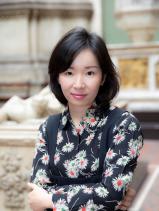
Yamada: The V&A was the first museum where Professor Ryо̄ Akama from the ARC conducted the digitization of a Japanese art collection in Europe 20 years ago. In this first phase of the partnership project, every single artwork from the Museum's extensive collection of ukiyo-e woodblock prints, numbering over 25,000 in total, was photographed. These images were subsequently uploaded onto the Museum's publicly accessible collection database, Explore the Collections. It was a remarkable achievement in the early 2000s when the digital presence of museums was fairly limited.
Soon after I joined the V&A in 2018, I had a chance to meet with Professor Akama and Dr. Ryо̄ko Matsuba, Lecturer in Digital Japanese Arts and Humanities at the Sainsbury Institute for the Study of Japanese Arts and Cultures (SISJAC), in London to discuss the possibility of initiating the second phase of the digitization project. The collections of ukiyo-e prints and illustrated books remain largely uncatalogued and without photographs in the case of the book collection. We agreed that there was much scope to improve the visibility and accessibility of these important collections. So, a collaborative project with the ARC was something I planned to initiate from the very beginning of my time at the V&A.
Could you please tell us the motivation and significance for your ARC-iJAC research project Re-thinking Japonisme: Digitization of the V&A's collection of Japanese ukiyo-e prints and illustrated books and researching its formation in the late 19th century?
Yamada: The current research project, launched in 2022, is expected to take at least a few years to complete considering the volume of the target areas. The prime objective is to systematically digitize the ukiyo-e woodblock prints and illustrated books in the V&A collection to provide a more comprehensive overview.
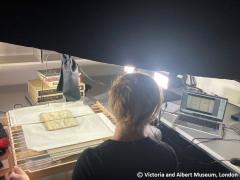 To date, three publications in English and two in Japanese on the ukiyo-e collection have been released between the 1980s and late 2000s. The 170 selected works traveled to Tokyo in 2007 for a special exhibition, Masterpieces of Ukiyo-e from the Victoria and Albert Museum, held at the Ōta Memorial Museum of Art in Tokyo, contributing to the collection's recognition in Japan. However, the selection of prints for these previous publications and the exhibition tended to focus on the most iconic prints of the ukiyo-e genre. The number of prints we can display in our permanent gallery of Japanese art is limited to no more than 15 at a time. I am excited to make thousands of prints that have never been displayed or published before accessible online through this project.
To date, three publications in English and two in Japanese on the ukiyo-e collection have been released between the 1980s and late 2000s. The 170 selected works traveled to Tokyo in 2007 for a special exhibition, Masterpieces of Ukiyo-e from the Victoria and Albert Museum, held at the Ōta Memorial Museum of Art in Tokyo, contributing to the collection's recognition in Japan. However, the selection of prints for these previous publications and the exhibition tended to focus on the most iconic prints of the ukiyo-e genre. The number of prints we can display in our permanent gallery of Japanese art is limited to no more than 15 at a time. I am excited to make thousands of prints that have never been displayed or published before accessible online through this project.The presence of the illustrated book collection, on the other hand, remains largely unknown despite its incredibly rich contents. There is only one publication on the collection compiled by Leonard G. Dawes in 1972. It introduced just a small selection of the most important titles, and there is currently no other publicly available resource to explore over 700 titles in the collection in full.
Our immediate focus is on the large group of Japanese prints and books acquired in 1886. The Museum purchased over 12,000 prints and 300 books as a single lot from a London-based art dealer, S. M. Franck, at the height of the European craze for all things Japanese. Analyzing print and book genres offered in this bulk acquisition would ultimately contribute to creating a new understanding of the Japanese art market in London in the late 19th century.
What do you hope to achieve with this joint research project?
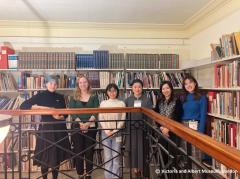 Yamada: I hope this collaborative project will further reinforce our existing partnership with the ARC and SISJAC. The V&A could not initiate this exciting new phase of the digitization project without their expertise and support.
Yamada: I hope this collaborative project will further reinforce our existing partnership with the ARC and SISJAC. The V&A could not initiate this exciting new phase of the digitization project without their expertise and support.
We are currently working together to make the ARC databases of the V&A's print and book collections publicly accessible. By interlinking the V&A's collection database in English with these specialist databases in Japanese, we will not only improve the accessibility of our collections for Japanese-speaking specialists and general audience, but also create opportunities for international specialists and audiences to discover the ARC's dedication and excellence in the field of Digital Humanities.
As part of the project, Dr. Matsuba from SISJAC regularly organizes hands-on digitizing workshops in the V&A, inviting young researchers and students. Spending one to two weeks, these workshops are designed to photograph the book collection for the above-mentioned databases. Every single book is being photographed from cover to cover, ensuring that new photographs meet today's publication standards. So far, seven university students and one researcher have taken part and learned best practices for digitizing museum collections. Offering learning opportunities for the next generation of researchers is another important goal for me.
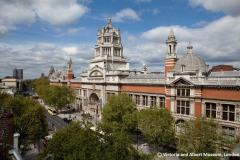 Could you give us an insight into your current role as curator at the V&A and what do you find particularly fascinating about the Japanese Collection of the Museum?
Could you give us an insight into your current role as curator at the V&A and what do you find particularly fascinating about the Japanese Collection of the Museum?Yamada: I am one of the three curators responsible for the Japanese art collections at the V&A. We hold over 48,000 objects in the Japanese art collections. Our permanent gallery, the Toshiba Gallery of Japanese Art, celebrates the extraordinary craftsmanship and artistic creativity of Japan from the sixth century to the present day through displays of swords and armor, lacquer, ceramics, cloisonné enamels, textiles and dress, inrō and netsuke, paintings, prints, and illustrated books, as well as contemporary craft, product design, fashion, and electronics.
While making our existing collections as widely accessible as possible through exhibitions, displays, research papers, lectures, and digitization is at the heart of our daily routine, the V&A is also committed to supporting and promoting new creative practices, acting as a resource and platform for contemporary artists, designers, and performers. As a Japanese national who has lived in Europe for many years, it is my passion to support contemporary Japanese practitioners and create opportunities to introduce their artistic creativity on the world stage.
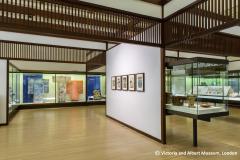
Our audience is diverse, not just in terms of nationalities, but also of age range. Young V&A (formerly the V&A Museum of Childhood) opened its doors to the public at the beginning of July 2023. This historic museum in East London has been entirely redesigned and is now reborn as a new museum where children, young people, and families can imagine, play and design. Its inaugural special exhibition will be all about Japan, Japan: Myths to Manga, and will open in October 2023. The exhibition has been collaboratively curated by Katy Canales, Young V&A Curator, with us in the Japan section of the V&A's Asia Department.
The ARC places great emphasis on fostering young researchers--the next generation of digital archiving experts. So, last but not least, based on your experience of studying and working in the UK, what would be your advice to students wishing to go abroad or join an international research project but worry about language barriers and other challenges?
Yamada: Studying and working abroad was the best thing I did in my early 20s. I highly recommend any early career researcher in Japan to go abroad or join an international research project if any opportunity arises. Although it has become easy to connect with international researchers virtually, meeting and working with them in person is an entirely different, far more powerful experience. Living in another country far from home is always challenging, but often life-changing and rewarding. It is exciting to exchange ideas with researchers from culturally diverse backgrounds who might have a completely different perspective on your research topic.
In terms of language barriers, I strongly believe the proverb, 'What one likes, one will do best.' If you are passionate about your research field, the most important thing is the contents of your research, and English is just a tool to communicate it. I went to a public school in Japan and could not speak English until I enrolled at the International Christian University in Tokyo, renowned for its fully bilingual education. So, my English was by no means perfect when I lived in London for the first time as a student, but I had learned that my Japanese heritage and language skill are unique assets that contribute to research projects in an international context.
Images credit line: Ⓒ Victoria and Albert Museum, London
(This interview was conducted by Yinzi Emily Li)
[イベント情報]July 14, 2023(Fri)The Art Research Center (ARC) and Hoosiers Corporation will be holding the Byobu Matsuri, or Folding Screen Festival--a traditional custom of the Gion Matsuri--at the Nagae Family Residence in Kyoto from July 14-16, 2023.
The Nagae Family Residence is a designated tangible cultural property by the City of Kyoto. Themed around 'plants' this year, folding screens and a selection of items from the collection of the Nagae Family Residence will be showcased.
The Nagae family were merchants of the kimono fabric. Their family residence, built between the late Edo period and the Taishō period, served both as a working and living space for many generations.
The ARC has been digital-archiving the collection belonging to the Nagae Family Residence after Ritsumeikan University received it as a donation. Subsequently, the ARC has become involved in planning and managing the Byobu Matsuri held annually at the residence.
This activity is based on an industry-academia collaboration with Hoosiers Corporation, concluded with a Memorandum of Understanding (MoU) on 27 May 2015, to preserve and utilize the Nagae Family Residence for the development and promotion of education and research.
Date: July 14 (10:00 - 20:00 JST), July 15 & 16, 2022 (10:00 - 19:00 JST, last admission 18:30)
Venue: Nagae Family Residence, Kyoto(京都市下京区新町通仏光寺上ル船鉾町394)
Reservations: Not required
Admission fee: 1,000 yen (including a postcard)
Inquiries
Email:nagaeke@hoosiers.co.jp
Tel:075-353-7512(weekdays only)Official website: http://www.nagaeke.jp/


